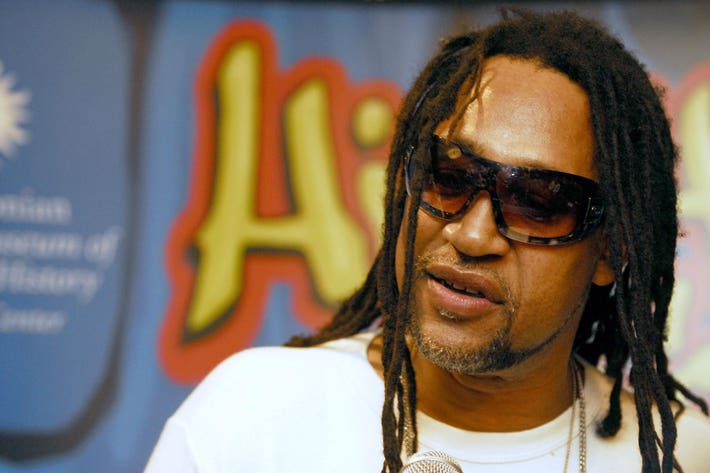Hip hop has something that most music can’t claim – a specific birthdate.
Classical? Jazz? Polka? Country or rock or pop? They might point to a century and a continent.
But hip hop has a date – Aug. 11, 1973. And a location – 1520 Sedgwick Ave. in West Bronx. And a performer – DJ Kool Herc (shown here0, then 18 years old. And an organizer – his little sister Cindy Campbell, trying to make money for back-to-school clothes.
And now its 50th anniversary is Friday.
Television started the party early – a “Fight the Power” documentary series January on PBS … an epic Grammys medley February on CBS … a three-year project on Showtime … and more. On the birthday, Showtime has a marathon, from 8 a.m. to 10 p.m.; the next day, A&E starts a three-Saturday artifact hunt, “Hip Hop Treasures.”
All of this points to the one large music genre that seems to know its exact roots.
Yes, people were rapping before this. But for the actual hip hop culture, sources point in one direction. “No man deserves more credit for planting the seeds of hip hop than Clive Campbell, a.k.a. Kool Herc,” S.H. Fernando Jr. wrote in “The Vibe History of Hip Hop” (Three Rivers Press, 1999).
Others would go on to make the records and the money. “Herc is more a myth than a man for even the truest hip hop fan,” Nelson George wrote in “Hip Hop America” (Viking Penguin, 1998). “Tapes of his performances are rare and, since the ‘80s, he has performed only sporadically.”
He grew up in the same Kingston, Jamaica area that produced reggae great Bob Marley. His mother moved to the U.S. when he was young, but he stayed behind. She sent him Motown and James Brown records, which he listened to alongside his dad’s reggae collection.
When he reached New York at about 13, he assimilated. He was tall and muscular, Havelock Nelson wrote in the Vibe book. “His aggressive style of (basketball) earned him the nickname Hercules.”
But his real interest was music. As a young DJ, he noticed that dance clubs came alive during instrumental breaks. “Instead of just playing hits, (he) sought out obscure records and played the instrumental breaks, extending them until they sounded like new records,” George wrote.
That’s what he did on Aug. 11, 1973. He brought two turntables, often combining them to prolong songs from James Brown’s “Sex Machine.”
That was in the community room of the apartment building where his family lived. His sister (later a Fashion Institute grad) wanted back-to-school clothes. She charged 25 cents and made about $300.
Soon, Herc was performing for free in parks and schoolyards. George recalled a 1978 show:
“At dusk, a van rolled up with Kool Herc and his crew. His boys dragged a couple of portable tables into the schoolyard through a hole in the fence, while Herc unscrewed a plate in the base of the light pole and hooked a heavy industrial extension cord to an outlet inside.”
In a story for the Amsterdam News, George described Herc as being “quietly calm, in a manner that makes adolescent girls giggle. His reputation as a party master is unsurpassed in the South Bronx.”
The techno side kept growing. Rob Kenner, in the Vibe book, described “ridiculous stacks of speakers in the park, microphone controllers rocking off the headtop until the breakadawn.”
The phrase “hip hop” would includes dancers – Herc coined the phrases “b-boys” and “b-girls” for the people dancing vibrantly during long breaks – and fashions and graffiti and maybe a general attitude.
George wrote about “the spirit of open-hearted innocence that created the hip hop culture. The idea of parties in parks and community centers, (where) money is not the goal.”
Eventually, there would be lots of money. The Sugar Hill Gang’s 1979 “Rappers Delight” reportedly sold two million copies in the U.S., reached No. 1 in Canada and did well worldwide.
The new age began and Kool Herc, now 68, stepped back. He has sometimes returned, including stopping developers from destroying 1520 Sedgwick Avenue, where it all started, 50 years ago.

Party time: On Aug. 11, hip hop turns 50
Hip hop has something that most music can’t claim – a specific birthdate.
Classical? Jazz? Polka? Country or rock or pop? They might point to a century and a continent.
But hip hop has a date – Aug. 11, 1973. And a location – 1520 Sedgwick Ave. in West Bronx. And a performer – DJ Kool Herc (shown here0, then 18 years old. And an organizer – his little sister Cindy Campbell, trying to make money for back-to-school clothes.
And now its 50th anniversary is Friday.
Television started the party early – a “Fight the Power” documentary series January on PBS … an epic Grammys medley February on CBS … a three-year project on Showtime … and more. On the birthday, Showtime has a marathon, from 8 a.m. to 10 p.m.; the next day, A&E starts a three-Saturday artifact hunt, “Hip Hop Treasures.” Read more…